Storming of the Bastille
| Storming of the Bastille | |||||||
|---|---|---|---|---|---|---|---|
| Part of the French Revolution | |||||||
 Prise de la Bastille by Jean-Pierre Houël | |||||||
| |||||||
| Belligerents | |||||||
|
|
Parisian militia Gardes françaises | ||||||
| Commanders and leaders | |||||||
|
| Pierre-Augustin Hulin | ||||||
| Strength | |||||||
| 114 soldiers, 30 artillery pieces | probably less than 1,000 insurgents | ||||||
| Casualties and losses | |||||||
| One (six or possibly eight killed after surrender) | 98 | ||||||
The Storming of the Bastille (French: Prise de la Bastille [pʁiz də la bastij]) occurred in Paris, France, on the afternoon of 14 July 1789. The medieval fortress, armory, and political prison in Paris known as the Bastille represented royal authority in the center of Paris. The prison contained just seven inmates at the time of its storming but was a symbol of abuses by the monarchy; its fall was the flashpoint of the French Revolution.
In France, Le quatorze juillet (14 July) is a public holiday, usually called Bastille Day in English.
Background
During the reign of Louis XVI, France faced a major economic crisis, partially initiated by the cost of intervening in the American Revolution, and exacerbated by a regressive system of taxation.[1] On 5 May 1789, the Estates-General of 1789 convened to deal with this issue, but were held back by archaic protocols and the conservatism of the Second Estate, consisting of the nobility and amounting to only 2% of France's population at the time.[2] On 17 June 1789, the Third Estate, with its representatives drawn from the commoners, reconstituted themselves as the National Assembly, a body whose purpose was the creation of a French constitution. The king initially opposed this development, but was forced to acknowledge the authority of the assembly, which subsequently renamed itself the National Constituent Assembly on 9 July.[3]
The commoners had formed the National Guard, sporting tricolour cockades (cocardes) of blue, white and red, formed by combining the red and blue cockade of Paris and the white cockade of the king. These cockades, and soon simply their colour scheme, became the symbol of the revolution and, later, of France itself.[4]
Paris, close to insurrection and, in François Mignet's words, "intoxicated with liberty and enthusiasm",[5] showed wide support for the Assembly. The press published the Assembly's debates; political debate spread beyond the Assembly itself into the public squares and halls of the capital. The Palais-Royal and its grounds became the site of an ongoing meeting.[6] The crowd, on the authority of the meeting at the Palais-Royal, broke open the prisons of the Abbaye to release some grenadiers of the French guards, reportedly imprisoned for refusing to fire on the people.[7] The Assembly recommended the imprisoned guardsmen to the clemency of the king; they returned to prison, and received pardon. The rank and file of the regiment, previously considered reliable, now leaned toward the popular cause.[8]
Necker's dismissal
On 11 July 1789, with troops at Versailles, Sèvres, the Champ de Mars, and Saint-Denis, Louis XVI, acting under the influence of the conservative nobles of his privy council, dismissed and banished his finance minister, Jacques Necker, who had been sympathetic to the Third Estate, and completely reconstructed the ministry.[9] The marshals Victor-François, duc de Broglie, la Galissonnière, the duc de la Vauguyon, the Baron Louis de Breteuil, and the intendant Foulon, took over the posts of Puységur, Armand Marc, comte de Montmorin, La Luzerne, Saint-Priest, and Necker.

News of Necker's dismissal reached Paris in the afternoon of Sunday, 12 July. The Parisians generally presumed that the dismissal marked the start of a coup by conservative elements.[10] Liberal Parisians were further enraged by the fear that a concentration of Royal troops, brought to Versailles from frontier garrisons, would attempt to shut down the National Constituent Assembly, which was meeting in Versailles. Crowds gathered throughout Paris, including more than ten thousand at the Palais-Royal. Camille Desmoulins successfully rallied the crowd by "mounting a table, pistol in hand, exclaiming: 'Citizens, there is no time to lose; the dismissal of Necker is the knell of a Saint Bartholomew for patriots! This very night all the Swiss and German battalions will leave the Champ de Mars to massacre us all; one resource is left; to take arms!'"[5]
The Swiss and German regiments referred to were among the foreign mercenary troops who made up a significant portion of the pre-revolutionary Royal Army, and were seen as being less likely to be sympathetic to the popular cause than ordinary French soldiers.[11] By early July, approximately half of the 25,000 regular troops in Paris and Versailles were drawn from these foreign regiments. The French regiments included in the concentration appear to have been selected either because of the proximity of their garrisons to Paris or because their colonels were supporters of the reactionary "court party" opposed to reform.[3]
During the public demonstrations that started on 12 July, the multitude displayed busts of Necker and of Louis Philippe II, Duke of Orléans, then marching from the Palais Royal through the theater district before continuing westward along the boulevards. The crowd clashed with the Royal German Cavalry Regiment ("Royal-Allemand") between the Place Vendôme and the Tuileries Palace. From atop the Champs-Élysées, the Prince de Lambesc unleashed a cavalry charge that dispersed the remaining protesters at Place Louis XV—now Place de la Concorde.[12] The Royal commander, Baron de Besenval, fearing the results of a blood bath amongst the poorly armed crowds or defections among his own men, then withdrew the cavalry towards Sèvres.[13] Meanwhile, unrest was growing among the people of Paris who expressed their hostility against state authorities by attacking customs posts blamed for causing increased food and wine prices.[14] The people of Paris started to plunder any place where food, guns and supplies could be hoarded. That night, rumors spread that supplies were being hoarded at Saint-Lazare, a huge property of the clergy, which functioned as convent, hospital, school and even as a jail. An angry mob broke in and plundered the property, seizing 52 wagons of wheat, which were taken to the public market. That same day multitudes of people plundered many other places including weapon arsenals. The Royal troops did nothing to stop the spreading of social chaos in Paris during those days.[15]
Armed conflict
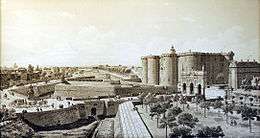
The regiment of Gardes Françaises (French Guards) formed the permanent garrison of Paris and, with many local ties, was favourably disposed towards the popular cause.[16] This regiment had remained confined to its barracks during the initial stages of the mid-July disturbances. With Paris becoming the scene of a general riot, Charles Eugene, Prince of Lambesc (Marshal of the Camp, Proprietor of the Royal Allemand-Dragoons), not trusting the regiment to obey his order, posted sixty dragoons to station themselves before its dépôt in the Chaussée d'Antin. The officers of the French Guards made ineffectual attempts to rally their men. The rebellious citizenry had now acquired a trained military contingent. As word of this spread, the commanders of the royal forces encamped on the Champ de Mars became doubtful of the dependability of even the foreign regiments.[17] The future "Citizen King", Louis-Philippe, duc d'Orléans, witnessed these events as a young officer and was of the opinion that the soldiers would have obeyed orders if put to the test. He also commented in retrospect that the officers of the French Guards had neglected their responsibilities in the period before the uprising, leaving the regiment too much to the control of its non-commissioned officers.[18] However, the uncertain leadership of Besenval led to a virtual abdication of royal authority in central Paris. A "bourgeois militia" arose through the sixty voting districts of Paris to take control over the insurrection.[19]
Storming the Bastille (14 July 1789)
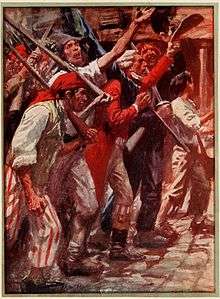
On the morning of 14 July 1789, the city of Paris was in a state of alarm. The partisans of the Third Estate in France, now under the control of the Bourgeois Militia of Paris (soon to become Revolutionary France's National Guard), had earlier stormed the Hôtel des Invalides without meeting significant opposition.[20] Their intention had been to gather the weapons held there (29,000 to 32,000 muskets, but without powder or shot). The commandant at the Invalides had in the previous few days taken the precaution of transferring 250 barrels of gunpowder to the Bastille for safer storage.[21]
At this point, the Bastille was nearly empty, housing only seven prisoners:[22] four forgers, two "lunatics" and one "deviant" aristocrat, the Comte de Solages (the Marquis de Sade had been transferred out ten days earlier).[21]
The cost of maintaining a garrisoned medieval fortress for so limited a purpose had led to a decision being made shortly before the disturbances began to replace it with an open public space.[23] Amid the tensions of July 1789 the building remained as a symbol of royal tyranny.
The regular garrison consisted of 82 invalides (veteran soldiers no longer suitable for service in the field).[24] It had however been reinforced on 7 July by 32 grenadiers of the Swiss Salis-Samade Regiment from the regular troops on the Champ de Mars.[25] The walls mounted eighteen eight-pound guns and twelve smaller pieces. The governor was Bernard-René de Launay, son of the previous governor and actually born within the Bastille.[21]
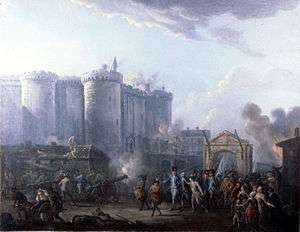
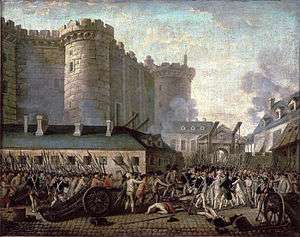
The official list of vainqueurs de la Bastille (conquerors of the Bastille) subsequently compiled has 954 names,[27] and the total of the crowd was probably fewer than one thousand. A breakdown of occupations included in the list indicates that the majority were local artisans, together with some regular army deserters and a few distinctive categories such as twenty-one wine merchants.[28]
The crowd gathered outside around mid-morning, calling for the surrender of the prison, the removal of the cannon and the release of the arms and gunpowder.[29] Two representatives of the crowd outside were invited into the fortress and negotiations began, and another was admitted around noon with definite demands. The negotiations dragged on while the crowd grew and became impatient.[30] Around 1:30, the crowd surged into the undefended outer courtyard. A small party climbed onto the roof of a building next to the gate to the inner courtyard and broke the chains on the drawbridge, crushing one vainqueur as it fell. Soldiers of the garrison called to the people to withdraw but in the noise and confusion these shouts were misinterpreted as encouragement to enter.[2] Gunfire began, apparently spontaneously, turning the crowd into a mob. The crowd seems to have felt that they had been intentionally drawn into a trap and the fighting became more violent and intense, while attempts by deputies to organise a cease-fire were ignored by the attackers.[2]
The firing continued, and after 3 pm the attackers were reinforced by mutinous gardes françaises, along with two cannons. A substantial force of Royal Army troops encamped on the Champs de Mars did not intervene.[31] With the possibility of mutual carnage suddenly apparent, Governor de Launay ordered a cease-fire at 5 pm. A letter offering his terms was handed out to the besiegers through a gap in the inner gate. His demands were refused, but de Launay nonetheless capitulated, as he realised that with limited food stocks and no water supply[28] his troops could not hold out much longer. He accordingly opened the gates to the inner courtyard, and the vainqueurs swept in to liberate the fortress at 5:30.[32]
Ninety-eight attackers and one defender had died in the actual fighting, a disparity accounted for by the protection provided to the garrison by the fortress walls.[33] De Launay was seized and dragged towards the Hôtel de Ville in a storm of abuse. Outside the Hôtel, a discussion as to his fate began.[34] The badly beaten de Launay shouted "Enough! Let me die!"[35] and kicked a pastry cook named Dulait in the groin. De Launay was then stabbed repeatedly and died; his head was cut off and put on a pike to be carried through the streets.[36] The three officers of the permanent Bastille garrison were also killed by the crowd; surviving police reports detail their wounds and clothing.[37] Two of the invalides of the garrison were lynched, but all but two of the Swiss regulars of the Salis-Samade Regiment were protected by the French Guards and eventually released to return to their regiment. Their officer, Lieutenant Louis de Flue, wrote a detailed report on the defense of the Bastille, which was incorporated in the logbook of the Salis-Samade and has survived.[38] It is (perhaps unfairly) critical of the dead Marquis de Launay, whom de Flue accuses of weak and indecisive leadership.[38] The blame for the fall of the Bastille would rather appear to lie with the inertia of the commanders of the 5,000[39] Royal Army troops encamped on the Champs de Mars, who did not act when either the nearby Hôtel des Invalides or the Bastille were attacked.
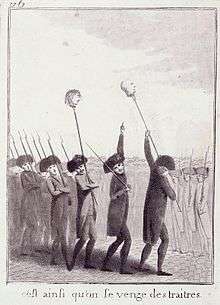
Returning to the Hôtel de Ville, the mob accused the prévôt ès marchands (roughly, mayor) Jacques de Flesselles of treachery, and he was assassinated en route to an ostensible trial at the Palais-Royal.[40]
Aftermath
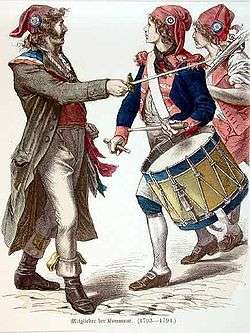
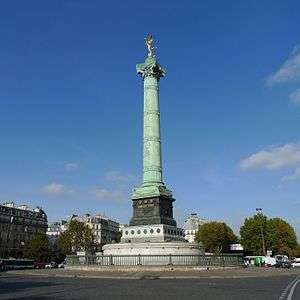
The king first learned of the storming only the next morning through the Duke of La Rochefoucauld. "Is it a revolt?" asked Louis XVI. The duke replied: "No sire, it's not a revolt; it's a revolution."[41]
The citizenry of Paris, expecting a counterattack, entrenched the streets, built barricades of paving stones, and armed themselves as well as they could, especially with improvised pikes. Meanwhile, at Versailles, the Assembly remained ignorant of most of the Paris events, but eminently aware that Marshal de Broglie stood on the brink of unleashing a pro-Royalist coup to force the Assembly to adopt the order of 23 June[42] and then to dissolve. The vicomte de Noailles apparently first brought reasonably accurate news of the Paris events to Versailles. M. Ganilh and Bancal-des-Issarts, dispatched to the Hôtel de Ville, confirmed his report.[43]
By the morning of 15 July, the outcome appeared clear to the king as well, and he and his military commanders backed down.[44] The Royal troops concentrated around Paris dispersed to their frontier garrisons. The Marquis de la Fayette took up command of the National Guard at Paris;[45] Jean-Sylvain Bailly – leader of the Third Estate and instigator of the Tennis Court Oath – became the city's mayor under a new governmental structure known as the Commune de Paris.[46] The king announced that he would recall Necker and return from Versailles to Paris; on 17 July, in Paris, he accepted a tricolour cockade from Bailly and entered the Hôtel de Ville to cries of "Long live the King" and "Long live the Nation".[47]
Nonetheless, after this violence, nobles – little assured by the apparent and, as it was to prove, temporary reconciliation of king and people – started to flee the country as émigrés.[48] Among the first to leave were the comte d'Artois (the future Charles X of France) and his two sons, the prince de Condé, the prince de Conti, the Polignac family, and (slightly later) Charles Alexandre de Calonne, the former finance minister. They settled at Turin, where Calonne, as agent for the count d'Artois and the prince de Condé, began plotting civil war within the kingdom and agitating for a European coalition against France.[49]
The news of the successful insurrection at Paris spread throughout France. In accord with principles of popular sovereignty and with complete disregard for claims of royal authority, the people established parallel structures of municipalities for civic government and militias for civic protection.[19] In rural areas, many went beyond this: some burned title-deeds and no small number of châteaux, as the "Great Fear" spread across the countryside during the weeks of 20 July to 5 August, with attacks on wealthy landlords impelled by the belief that the aristocracy was trying to put down the revolution.[50][51]
On July 22, 1789 the populace lynched Joseph Foullon de Doué and his son-in-law[52] Louis Bénigne François Bertier de Sauvigny. Both held official positions under the monarchy.
Although there were arguments that the Bastille should be preserved as a monument to liberation or as a depot for the new National Guard, the Permanent Committee of Municipal Electors at the Paris Town Hall gave the construction entrepreneur Pierre-François Palloy the commission of disassembling the building.[53] Palloy commenced work immediately. The demolition of the fortress itself, the melting down of its clock portraying chained prisoners, and the breaking up of four statues were all carried out within five months.[54]
Austrian composer Carl Ditters von Dittersdorf wrote his Symphony in C Major as a tribute to the event. The first movement of the piece is known as La Prise De La Bastille.
In Book 2 of Charles Dickens' A Tale of Two Cities, the Defarges help lead the assault on the Bastille.
In 1790, Lafayette gave the cast-iron, one-pound and three-ounce key to the Bastille to American President George Washington. Washington displayed it prominently at government facilities and events in New York and in Philadelphia until shortly before his retirement in 1797. The key remains on display at Washington's residence of Mount Vernon.[55]
See also
- 1789: Les Amants de la Bastille, stage musical whose 2 main characters are split up during the French Revolution, then reunite during the storming of the Bastille
References
- ↑ Simon Schama, pages 60-71 Citizens: A Chronicle of the French Revolution, ISBN 0-670-81012-6
- 1 2 3 Simon Schama, page 402 Citizens: A Chronicle of the French Revolution, ISBN 0-670-81012-6
- 1 2 M. J. Sydenham, page 46 The French Revolution, B. T. Batsford Ltd London 1965
- ↑ Georges Lefebvre, page 114 The Coming of the French Revolution, ISBN 9780691121888
- 1 2 Mignet 1824, §Chapter I
- ↑ Simon Schama, pages 370-371 Citizens: A Chronicle of the French Revolution, ISBN 0-670-81012-6
- ↑ Simon Schama, page 371 Citizens: A Chronicle of the French Revolution, ISBN 0-670-81012-6
- ↑ Simon Schama, page 375 Citizens: A Chronicle of the French Revolution, ISBN 0-670-81012-6
- ↑ Munro Price, pages 85-87 The Fall of the French Monarchy, ISBN 0-330-48827-9
- ↑ Munro Price, page 85 The Fall of the French Monarchy, ISBN 0-330-48827-9
- ↑ Munro Price, page 76 The Fall of the French Monarchy, ISBN 0-330-48827-9
- ↑ Micah Alpaugh, "The Politics of Escalation in French Revolutionary Protest: Political Demonstrations, Nonviolence and Violence in the Grandes journees of 1789", French History (Fall 2009)
- ↑ Simon Schama, page 385 Citizens: A Chronicle of the French Revolution, ISBN 0-670-81012-6
- ↑ Richard Cobb and Colin James, page 73 The French Revolution. Voices From a Momentous Epoch 1789–1795, CN 8039 Guild Publishing 1988
- ↑ Louis, Bergeron (1970). Le Monde et son Histoire. Paris. p. Volume VII, Chapter VI. Micah Alpaugh, "The Politics of Escalation in French Revolutionary Protest: Political Demonstrations, Nonviolence and Violence in the Grandes Journees of 1789", French History (2009)
- ↑ Terry Crowdy, page 6 French Revolutionary Infantry 1789–1802, ISBN 1-84176-660-7
- ↑ Munro Price, pages 96-97 The Fall of the French Monarchy, ISBN 0-330-48827-9
- ↑ Comments recorded in diary entries made by Louis-Philipp during 1789
- 1 2 Richard Cobb and Colin James, page 75 The French Revolution. Voices From a Momentous Epoch 1789–1795, CN 8039 Guild Publishing 1988
- ↑ Richard Cobb and Colin James, page 68 The French Revolution. Voices From a Momentous Epoch 1789–1795, CN 8039 Guild Publishing 1988
- 1 2 3 Simon Schama, page 399 Citizens: A Chronicle of the French Revolution, ISBN 0-670-81012-6
- ↑ Civilisation: A Personal View, Kenneth Clark, Penguin, 1987, p. 216
- ↑ Simon Schama, page 398 Citizens: A Chronicle of the French Revolution, ISBN 0-670-81012-6
- ↑ Connelly, Owen (2006). The Wars of the French Revolution and Napoleon 1792–1815. New York: Routledge. p. 18.
- ↑ Christopher J. Tozzi, pages 54 "Nationalizing France's Army. Foreign, Black and Jewish Troops in the French Military, 1715-1831, ISBN 978-0-8139-3833-2
- ↑ http://www.nytimes.com/2013/01/10/arts/design/paris-3d-a-digital-model-of-the-french-capital.html?partner=rss&emc=rss
- ↑ Hibbert, Christopher. The French Revolution (1980), p. 82 (1982 Penguin Books edition)
- 1 2 Simon Schama, page 400 Citizens: A Chronicle of the French Revolution, ISBN 0-670-81012-6
- ↑ Simon Schama, pages 399 Citizens: A Chronicle of the French Revolution, ISBN 0-670-81012-6
- ↑ Simon Schama, page 400-401 Citizens: A Chronicle of the French Revolution, ISBN 0-670-81012-6
- ↑ Munro Price, page 89 The Fall of the French Monarchy, ISBN 0-330-48827-9
- ↑ Simon Schama, page 403 Citizens: A Chronicle of the French Revolution, ISBN 0-670-81012-6
- ↑ Simon Schama, pages 403-404 Citizens: A Chronicle of the French Revolution, ISBN 0-670-81012-6
- ↑ Simon Schama, page 404 Citizens: A Chronicle of the French Revolution, ISBN 0-670-81012-6
- ↑ Simon Schama, page 405 Citizens: A Chronicle of the French Revolution, ISBN 0-670-81012-6
- ↑ Simon Schama, page 404 Citizens: A Chronicle of the French Revolution, ISBN 0-670-81012-6
- ↑ J. B. Morton, appendix The Bastille Falls: and other studies of the French Revolution, Longmans, Green & Co, London 1936
- 1 2 "Rélation de la prise de la Bastille le 14 juillet 1789 par un de ses défenseurs", in Révue Retrospective, vol. 4 (Paris: M. J. Taschereau, 1834)
- ↑ Christopher Hibbert, page 70 The French Revolution, ISBN 978-0140049459
- ↑ Hibbert, Christopher (1980). The Days of the French Revolution. New York: William Morrow and Co. pp. 69–82. ISBN 0-688-03704-6.
- ↑ Guy Chaussinand-Nogaret, La Bastille est prise, Paris, Éditions Complexe, 1988, p. 102.
- ↑ "The Séance royale of 23 June 1789". Fitchburg State College. Retrieved 22 January 2009.
- ↑ Simon Schama, pages 419-420 Citizens: A Chronicle of the French Revolution, ISBN 0-670-81012-6
- ↑ Munro Price, page 92 The Fall of the French Monarchy, ISBN 0-330-48827-9
- ↑ Terry Crowdy, page 9 French Revolutionary Infantry 1789–1802, ISBN 1-84176-660-7
- ↑ François Furet and Mona Ozouf, eds. A Critical Dictionary of the French Revolution (1989), pp 519-28
- ↑ M. J. Sydenham, page 50 The French Revolution, B. T. Batsford Ltd London 1965
- ↑ Munro Price, page 93 The Fall of the French Monarchy, ISBN 0-330-48827-9
- ↑ Richard Cobb and Colin James, page 129 The French Revolution. Voices From a Momentous Epoch 1789–1795, CN 8039 Guild Publishing 1988
- ↑ M. J. Sydenham, page 54 The French Revolution, B. T. Batsford Ltd London 1965
- ↑ Richard Cobb and Colin James, page 77 The French Revolution. Voices From a Momentous Epoch 1789–1795, CN 8039 Guild Publishing 1988
- ↑ M. J. Sydenham, page 55 The French Revolution, B. T. Batsford Ltd London 1965
- ↑ Simon Schama, page 412 Citizens: A Chronicle of the French Revolution, ISBN 0-670-81012-6
- ↑ Simon Schama, page 414 Citizens: A Chronicle of the French Revolution, ISBN 0-670-81012-6
- ↑ "Bastille Key". Digital Encyclopedia of George Washington. Mount Vernon Ladies' Association. Retrieved 15 November 2015.
Additional sources
-
 This article incorporates text from a publication now in the public domain: Chisholm, Hugh, ed. (1911). "article name needed". Encyclopædia Britannica (11th ed.). Cambridge University Press.
This article incorporates text from a publication now in the public domain: Chisholm, Hugh, ed. (1911). "article name needed". Encyclopædia Britannica (11th ed.). Cambridge University Press. - This article incorporates text from the public domain History of the French Revolution from 1789 to 1814, by François Mignet (1824), as made available by Project Gutenberg.
Further reading
- Alpaugh, Micah. "The Politics of Escalation in French Revolutionary Protest: Political Demonstrations, Nonviolence and Violence in the Grandes journees of 1789", French History (Fall 2009).
- Alpaugh, Micah. "A Self-Defining Bourgeoisie in the Early French Revolution: The Milice bourgeoise, the Bastille Days of 1789, and their Aftermath", Journal of Social History 47, no. 3 (Spring 2014), 696-720.
- Lüsebrink, Hans-Jürgen; Reichardt, Rolf; Schürer, Norbert (1997). The Bastille. Duke University Press. ISBN 978-0-8223-1894-1.
- Mignet, Francois-Auguste (1 January 2006). History of the French Revolution from 1789 to 1814.
- Taylor, David (1997). The French Revolution. Heinemann. pp. 16–17. ISBN 978-0-435-31694-5.
- Stephens, Henry Morse (1886). A History of the French Revolution. C. Scribner's sons. pp. 128–168.
- Sewell, William H. "Historical Events as Transformations of Structures: Inventing Revolution at the Bastille", Theory and Society 25, no. 6 (Dec., 1996), 841-881.
- Abbott, John Stevens Cabot (1887). The French Revolution of 1789 as Viewed in the Light of Republican Institutions. Jefferson Press. pp. 112–122.
External links
| Wikimedia Commons has media related to Storming of the Bastille. |
- Place de la Bastille - Official French website (in English)
- Thomas Jefferson's letter to John Jay recounting the storming of the Bastille